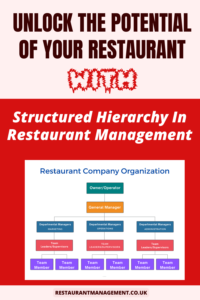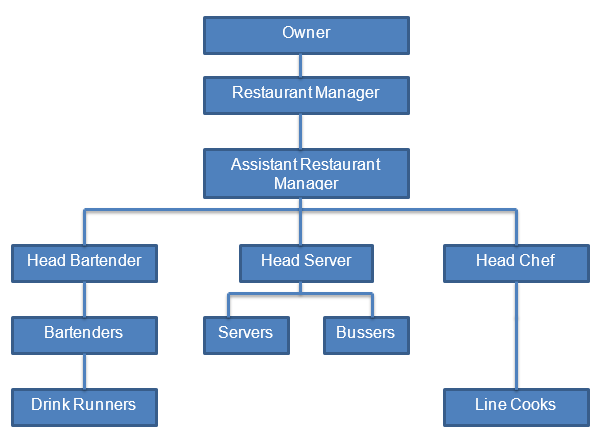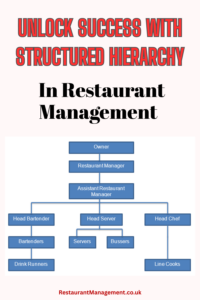Creating a Hierarchy in Restaurant Management Structure
The foundation of effective restaurant operation lies in creating a hierarchy in restaurant management structure. Understanding the importance of a well-structured hierarchy in restaurant management is essential for comprehending how responsibilities are distributed and executed. This organisational framework guides the functionality of the restaurant and defines the roles and relationships within the structure.
Understanding the significance of this structure is equally vital, as it forms the bedrock for efficient operations, ensuring seamless coordination among various facets of the restaurant. From front-of-house to back-of-house operations, a well-defined management structure enhances workflow and plays a pivotal role in achieving long-term business sustainability.

Importance of a Well-Defined Structure
In the dynamics of restaurant management, establishing a well-defined hierarchy in restaurant management structure is a cornerstone for success. The importance is twofold, primarily focused on enhancing operational efficiency and concurrently elevating the customer experience.
- Firstly, a structured framework aids in operational efficiency by clearly outlining roles and responsibilities. From the front-of-house operations to the intricacies of back-of-house functions, a clearly defined structure minimises confusion, streamlines processes, and enhances overall productivity.
- Secondly, the impact of a well-organised structure reverberates in providing an excellent customer experience. When staff members operate within a clearly defined structure, it translates to seamless service and heightened customer satisfaction. From efficient order processing to attentive table service, a structured management system optimises every aspect of the customer journey.
In essence, a mutual relationship between operational efficiency and customer experience underscores the pivotal role that a well-defined structure plays in shaping the success of a restaurant, making it a fundamental consideration for those navigating the challenges of the hospitality industry.
Key Components of a Hierarchy in Restaurant Management Structure
Front-of-House Operations
Efficient front-of-house operations are paramount to a restaurant’s success, setting the tone for the overall dining experience. This section of your restaurant structural organisation should dissect the critical components of the front-of-house within the restaurant management structure.
- Host/Hostess Responsibilities:
At the forefront of guest interaction, hosts and hostesses play a pivotal role in creating a positive first impression. You should outline their responsibilities, including managing reservations, greeting customers, and overseeing the seating arrangement to ensure a smooth and welcoming customer entry.
- Server Roles and Responsibilities:
The heartbeat of the dining area and servers contribute significantly to customer satisfaction. This segment describes the roles and responsibilities of servers, encompassing order-taking, food and beverage recommendations, and the seamless delivery of services. Understanding the nuances of server responsibilities is crucial for optimising the overall dining experience.
- Bartender Duties:
The focal point of beverage service, bartenders wield a unique influence on the atmosphere of a restaurant. Outline the duties of bartenders, from crafting signature drinks to maintaining an organised and well-stocked bar. Acknowledging the diverse responsibilities of bartenders sheds light on their integral role in enhancing the overall ambience and customer satisfaction within the establishment’s front-of-house operations.

Back-of-House Operations
The backbone of a restaurant’s functionality lies in its back-of-house operations, where culinary mastery and meticulous organisation converge. This section should look into the critical components of the back-of-house within the restaurant management structure.
- Chef and Kitchen Staff Hierarchy:
At the helm of culinary excellence, the chef and kitchen staff form a structured hierarchy essential for the seamless preparation and presentation of dishes. This subsection should outlines the hierarchical arrangement within the kitchen, detailing the roles and responsibilities of head chefs, sous chefs, line cooks, and other kitchen personnel. Understanding this hierarchy is crucial for optimising kitchen efficiency and maintaining the quality of culinary offerings.
- Dishwashing and Cleaning Crew Roles:
Behind the scenes, the dishwashing and cleaning crew are indispensable in upholding sanitation standards and ensuring a hygienic environment. This segment should shed light on the responsibilities of these essential team members, encompassing dishwashing protocols, kitchen cleanliness, and overall maintenance. Recognising the significance of these roles contributes to the overall operational efficiency and hygiene standards within the restaurant’s back-of-house operations.
Managerial Roles
Effective restaurant management requires skilled leadership to navigate the complexities of daily operations. This section explores the distinct managerial roles within the restaurant management structure.
- General Manager Responsibilities:
At the pinnacle of a structured hierarchy in restaurant management, the General Manager shoulders overarching responsibilities for the restaurant’s success. This subsection describes the multifaceted role of the General Manager, encompassing tasks such as strategic planning, staff supervision, financial management, and ensuring overall operational excellence. Understanding the breadth of the General Manager’s responsibilities is fundamental to steering the restaurant toward sustained success and customer satisfaction.
- Assistant Manager Duties:
The Assistant Manager serves as a crucial supporting figure, contributing to the efficient functioning of the restaurant. This segment should detail the specific duties undertaken by Assistant Managers, including staff coordination, customer service supervision, and assisting in managerial tasks. Recognising the Assistant Manager’s role is essential for fostering a collaborative managerial environment, ensuring smooth day-to-day operations, and maintaining the high standards set by the restaurant management structure.
Organisational Charts in Restaurant Management
Efficient restaurant management thrives on well-defined organisational structures.
- Designing a Functional Organisational Chart
An effective organisational chart is pivotal for describing roles and establishing clear lines of authority. A functional organisational chart should be tailored to the unique needs of restaurant management. It should cover all aspects, including departmental divisions, reporting relationships, and the integration of key roles. Understanding the intricacies of designing an organisational chart ensures a visual representation that enhances communication and fosters a harmonious working environment.
- Role Clarity and Hierarchy
Clear roles and a precisely outlined hierarchy are vital to a successful organisational chart. This section underscores the importance of role clarity, ensuring that each team member comprehends their responsibilities and contribution to the restaurant’s overall success. Additionally, it should explores and establish a clear hierarchy within the organisational chart and defining reporting structures and lines of authority. Establishing role clarity and hierarchy allows the restaurant management structure to operate seamlessly, promoting effective communication and collaboration among team members.

Developing Effective Communication Channels
Smooth communication is the lifeblood of successful restaurant management. There should be a structure that explores strategies for fostering effective communication within and beyond the restaurant team.
- Interdepartmental Communication Strategies
Creating efficient communication across various departments is vital for optimising operations within a restaurant. This entails implementing interdepartmental communication strategies crafted to foster collaboration and synergy. These strategies encompass regular meetings, the sharing of documentation, and cross-training initiatives, ensuring a smooth exchange of information between the front-of-house and back-of-house teams. These strategies’ thorough understanding and application elevate the restaurant’s overall coordination, operational efficiency, and internal cohesion.
- Utilising Technology for Seamless Communication
The use of technology enhances communication and can be harnessed for seamless interaction. From point-of-sale systems linking orders directly to the kitchen to communication platforms facilitating real-time updates, technology provides tools that streamline communication processes. Technology integration ensures prompt information sharing, improves order accuracy, and enhances communication efficiency. Embracing technological solutions contributes to a modern, efficient, and customer-focused approach to restaurant management.

Training and Development Programs
Investing in employee training and development is a cornerstone of successful restaurant management. Make the most of the significance of ongoing training and the creation of practical training modules.
Importance of Ongoing Training
Continuous training is vital in the dynamic restaurant industry. It highlights the benefits of keeping employees updated on industry trends, customer service standards, and operational procedures. Ongoing training enhances employee skills and fosters a culture of adaptability, ensuring that the restaurant team remains well-prepared to meet evolving challenges in the competitive hospitality landscape.
Creating Effective Training Modules
Designing practical training modules is critical to ensuring staff members receive valuable and relevant instruction. This part should explore the process of creating training modules that align with the restaurant’s goals and values, including hands-on experiences, multimedia resources, and interactive elements to engage and educate employees effectively. By developing tailored training modules, restaurant managers can cultivate a skilled and knowledgeable team, contributing to a consistently high level of service and operational excellence.

Related articles:
How To Improve Restaurant Profits
Effective Leadership In Restaurants
Staffing Strategies in the Restaurant Industry
Navigating the challenges of staffing is crucial for the success of any restaurant. This section should highlight practical strategies for recruiting talent and implementing initiatives to retain valuable employees.
Recruiting the Right Talent
The cornerstone of a prosperous restaurant lies in forming a skilled and dedicated team. Recruiting talent is a strategic investment in building a high-performing and cohesive team. This necessitates a thoughtful approach to recruiting strategies, encompassing the definition of job roles and qualifications and implementing targeted recruitment channels.
This comprehensive recruitment methodology ensures that the workforce is not only qualified but also culturally attuned, fostering an environment conducive to the restaurant’s overall success and enduring excellence. It should emphasise the importance of aligning the recruitment process with the restaurant’s culture and values, ensuring a workforce that possesses the necessary skills is committed to delivering exceptional service.
Employee Retention Initiatives
Retaining skilled and motivated employees is as vital as recruiting them. This part of the structure should outline the proactive initiatives to enhance employee retention within the restaurant industry. This organisational structure section details proactive strategies to improve employee retention within the restaurant industry. It encompasses various elements, including providing competitive compensation packages, opportunities for professional development, and fostering a positive work environment.
By implementing effective retention strategies, restaurant managers can foster loyalty among their staff, reducing turnover and maintaining a team dedicated to delivering outstanding service and contributing to the overall success of the establishment.
Happy Restaurant Staff: 20 Tips On How To Make Your Employees Happy
Legal and Compliance Aspects
Adhering to legal and compliance standards is imperative for the seamless operation of restaurants. This section should document the key aspects of restaurant management regarding legal obligations and compliance, focusing on understanding labour laws and ensuring health and safety standards.
- Understanding Labour Laws
A solid grasp of labour laws is essential in the complex landscape of restaurant management. This subsection should highlight the nuances of UK labour laws, encompassing aspects such as minimum wage requirements, working hours, and employee rights. By understanding and following these regulations, restaurant managers cultivate a just and legal workplace, safeguarding the well-being of their employees and advocating for ethical employment practices.
- Health and Safety Compliance in Restaurants
Prioritising health and safety measures are paramount in the restaurant industry. This part of your organisation structure should explore the necessary compliance protocols, covering areas such as food safety, sanitation, and general workplace safety. By implementing and enforcing rigorous health and safety standards, restaurant managers protect the health of staff and customers and align with regulatory requirements. This commitment not only reduces operational risks but also upholds the reputation and credibility of the restaurant, ensuring a secure and compliant environment for all stakeholders.
Crisis Management Protocols
In the dynamic realm of restaurant operations, having effective crisis management protocols is imperative for ensuring the safety of patrons and staff. You should have procedures for handling emergencies within the restaurant and emphasise the crucial role of communication during crises.
- Handling Emergencies in the Restaurant
Unforeseen emergencies can pose a significant threat to the well-being of customers and employees. Addressing the protocols and procedures for effectively managing emergencies such as fires, medical incidents, or natural disasters within the restaurant premises will enhance your restaurant’s reputation and staff retention. By establishing clear guidelines, conducting regular drills, and providing staff with proper training, restaurant management can minimise risks and ensure a swift, organised response in critical situations.
- Communication During Crises
Transparent and efficient communication is vital when facing crises. This part delves into the strategies for maintaining effective communication during emergencies. It covers aspects such as notifying relevant parties, disseminating information to staff and customers, and utilising various communication channels. Timely and clear communication not only aids in managing the immediate crisis but also contributes to maintaining trust and reputation in the aftermath. By integrating strong communication practices into crisis management protocols, restaurants can navigate challenges with resilience and uphold their commitment to the safety and well-being of all stakeholders.

Conclusion
Emphasising the Impact of a Well-Organised Management Structure
In the culmination of our exploration into restaurant management, it becomes evident that a well-organised management structure is the linchpin of success in the culinary world. The intricacies of front-of-house and back-of-house operations, managerial roles, communication strategies, training programs, and adherence to legal and compliance standards collectively contribute to the harmonious functioning of a restaurant.
Emphasising the profound impact of a well-organised management structure underscores its role as the foundation for operational efficiency, customer satisfaction, and sustained growth. A structured hierarchy and clear communication channels create a dynamic environment where each team member understands their role, fostering a collaborative spirit that propels the restaurant towards excellence.
Frequently Asked Questions (FAQs)
What is the management structure of a restaurant?
The organisational framework of a restaurant generally encompasses a variety of crucial roles. At the top is the A Hierarchy In Restaurant Management is the General Manager, who is responsible for overall operations, strategic planning, and team coordination. Underneath may be Assistant Managers or Deputy Manager overseeing areas such as front-of-house or back-of-house operations. The hierarchical structure usually includes positions like Head Chef or Kitchen Manager, Front-of-House Manager, and various supervisory roles. Team members, such as servers, cooks, and cleaning staff, contribute to the operational flow. Clear communication channels and a well-defined organisational chart are essential for effective management.
What is the hierarchical structure of a restaurant?
The hierarchical structure of a restaurant generally follows a pyramid-like shape. At the top is the General Manager, followed by Assistant Managers who may oversee specific departments. There is a Head Chef or Kitchen Manager in the kitchen, and there might be a Front-of-House Manager on the front end. Supervisors and team leads may exist within each department, overseeing servers, cooks, and support staff. The hierarchy ensures clear reporting lines and delineation of responsibilities, contributing to efficient operations.
What are the levels of managers in a restaurant?
The cornerstone of a prosperous restaurant lies in forming a skilled and dedicated team. This necessitates a thoughtful approach to recruiting strategies, encompassing the definition of job roles and qualifications and implementing targeted recruitment channels. The success of a restaurant hinges on the careful selection and alignment of a team possessing the requisite skills and sharing a commitment to the establishment’s values. This comprehensive recruitment methodology ensures that the workforce is not only qualified but also culturally attuned, fostering an environment conducive to the restaurant’s overall success and enduring excellence.
The top-level manager is typically the General Manager, responsible for overall leadership. Assistant Managers may operate at the next level, overseeing specific areas like operations, finance, or human resources. Departmental managers, such as Kitchen Managers or Front-of-House Managers, follow. Supervisors and team leads may exist within each department, overseeing staff. Efficient communication and collaboration across these tiers are imperative for the prosperous management of a restaurant.



